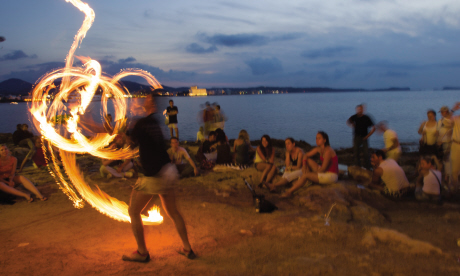
Don’t leave the camera behind on your evenings out! Steve Davey helps you capture those cultural shows, campfire drinks and bar crawls that make travelling so much fun...
It doesn’t matter if you’re an Ibiza club-bunny or a culture-vulture taking in some Sichuan Opera, a lot of the fun on your travels will happen once the sun has set. The night hours don’t have to be a blank in your photo album though.
One of the key things about photographing your evenings out is to ensure you still have the evening out. Don’t tag along with your friends and be the official photographer. Make sure that the photographic decisions you make still allow you to have a good time, otherwise what is the point?
Consider packing a smaller, cheaper camera for night-time forays. It will be easier to carry, more discrete and less upsetting to lose. Even so, do back up your pictures before taking your camera out on the town, so you won’t loose any images if the worst happens.
Lighting is a key issue. When you shoot at night, you will be photographing in low levels of artificial light or in darkness. You can use the flash, but this is intrusive, and will generally kill the picture’s atmosphere. Unless there is almost no light at all, you will get much more atmospheric images if you increase the ISO sensitivity and shoot with available light.
Most modern cameras – including compacts and even camera phones – have an incredible ability to shoot in low light levels without giving noise that is too intrusive. And, anyway, you’re often seeking a picture that gives an impression of your great night out – not a pin-sharp masterpiece.
If you do use flash, select a slow-sync mode. This is when the camera balances the flash with the ambient light. The partial blurring this gives is a really dynamic effect. If you are photographing a cultural performance, you will have to use the available light and not flash. This shouldn’t be a problem: in general, stage light will be bright and the performers well lit. Shows that are designed for tourists will usually permit photography, but do ask first.
If you are snapping your fellow revellers, try to be discrete – you will be rewarded with more natural shots if people aren’t aware you’re photographing them. Also, compose shots to include the rest of the bar/club/theatre etc, to give more of a sense of place.
Above all, photograph with a sense of involvement and enjoyment and this will come over in your pictures.
Sometimes details can be easier to photograph than a whole bar or restaurant. Look for something that encompasses where you are: it could be food or an object. Show the venue in the background for context.
If you are photographing a performance you might not always be able to get near enough to the front for close ups. If not, then photograph the whole stage to give an impression of the event. This will allow you to fill the frame with the stage lighting and, as in this case, the giant screen. Wait for a dramatic moment before shooting.
Artificial light can result in a green or yellow cast on your pictures. This can be neutralised using the Auto White Balance facility, but you’ll get a more controlled result by shooting in RAW format and adjusting the white balance in post processing.
Consider handholding your camera while using a slow shutter speed. This will allow a moving subject to blur, giving a more dynamic result. You may get some camera shake, but this isn’t an issue as long as the subject is moving more! A wide-angle lens is easier to keep still than a telephoto.
Don’t be a flasher! Your flash will ruin the mood of the picture. Either use a slow shutter speed or increase the ISO and handhold for a less intrusive, more atmospheric image.
You’ll have to manage the white balance to control colour casts from artificial light. Shoot
RAW and do this in post-production when you have more control than the Auto White Balance facility.
Use a monopod in places where you can’t use a tripod. It won’t hold the camera as still, but it can make the difference between having camera shake in your image, or keeping the camera still for relatively long exposures.
Steve leads a range of travel photography tours, with land arrangements by Intrepid Travel; see www.bettertravelphotography.com.
Read more of Steve’s tips in our sister publication, Take Better Travel Photos www.TakeBetterTravelPhotos.co.uk